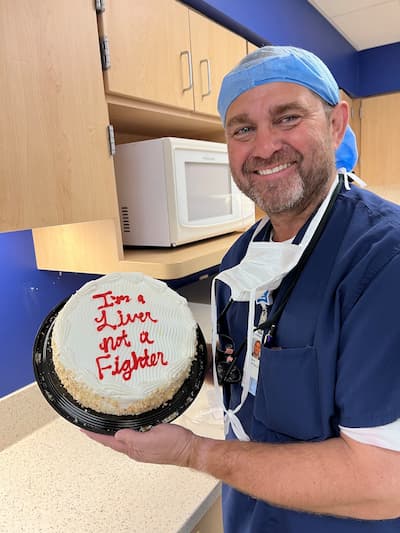Milestone Moment: Dr. Hendrickson’s 100th Liver Transplant

Richard Hendrickson, MD, FACS, FAAP, Surgical Director, Small Intestine Rehabilitation and Surgical Director, Prenatal Consultation, Surgery, recently completed his 100th liver transplant at Children’s Mercy, but that personal milestone is just the latest in a series of notable “firsts” the surgeon has been involved in during his 14 years at the hospital.
For example, Dr. Hendrickson:
-
Contributed to completing a split liver and kidney dual-organ transplant in 2013.
-
Participated in the 100th Children’s Mercy liver transplant in 2014.
-
Performed (with another surgeon) the first simultaneous kidney transplants at Children’s Mercy in 2016.
-
Conducted (with others) the hospital’s 299th and 300th kidney transplants in a back-to-back marathon, 13-hour Operating Room Session.
-
Completed the hospital’s first en bloc liver/kidney transplant in 2023, along with Dr. Bhargava Mullapudi, co-director, Brendan Tripp Elam Transplant Center.
Also, in 2012, Dr. Hendrickson completed the liver transplant for Brendan Elam, namesake of the Children’s Mercy Brandon Tripp Elam Transplant Center.
“Combined, we’ve done nearly 600 (596) liver and kidney transplants at Children’s Mercy, and I’ve been involved in nearly half of them (263 or 44%),” Dr. Hendrickson said. The hospital has completed 186 liver transplants (and, as mentioned, Dr. Hendrickson has done 100 of those and expects to be part of the 200th) and 410 kidney transplants, of which he has been involved in the 300th and 400th milestone procedures.
Every case is unique
No two surgical procedures are alike, none are routine and many other surgeries are conducted in addition to transplants.
“Every case is different; that’s what I teach the fellows,” he said. “Even an appendectomy can be extraordinarily challenging. Even a case that you might think to be straightforward can always have some challenge or magnitude of difficulty you don’t anticipate or see. I continue to learn every day.”
The job entails long, irregular hours – often at night, on weekends and holidays; Dr. Hendrickson has even done a surgery on his birthday. During a recent three-day span, Dr. Hendrickson performed 20 surgeries. “It was a busy weekend,” he said.
The rewards of his profession offset the demands, and no case stands out in his mind as the most memorable.
“I think all cases are rewarding," Dr. Hendrickson said. “If I can get a child out of the hospital in good health, that’s rewarding. Even small cases mean a lot to a family; they put their trust in you, and I always appreciate that. I always like to have an excellent rapport with the family. I like the kids to be involved in all the discussions and decisions so that they’re not afraid. I’m as transparent as possible: the good, the bad and the ugly.”
The Southern California native crossed the country to attend medical school and internship at Georgetown University in Washington D.C.; his residency was at Strong Memorial Hospital in Rochester N.Y., and his fellowships in Pediatric Surgery and Transplant Surgery at the University of Colorado School of Medicine in Aurora, Colorado.
“I wanted to be a doctor since I was about 8 years old, decided to become a surgeon in medical school and chose pediatrics when I did my rotation on pediatric surgery at Georgetown. I liked pediatric surgery because children are innocent; they don’t understand why they’re sick, so I felt like it was my mission to help them get well.”
Tribute to organ donors
Transplant procedures also take time to recognize organ donors and their families. “The scrub team holds hands and we observe a moment of silence to acknowledge the donor,” he said. “On one side of a transplant there is tragedy; on the other side is a treasure: the gift of life.” The team also accommodates anything the donor family wishes to say or have read.
The joy of a successful transplant procedure is made possible by what Dr. Hendrickson calls, “A very comprehensive and cohesive support system that includes operating room nurses, hepatologists and hepatology coordinators, nurse practitioners, nurse liver coordinators, Infectious Diseases, Interventional Radiology, pathology, Child Life, Nutrition, Pharmacy and more.
“I’m just a piece in a big puzzle that works,” he said.
Asked about his vision for the transplant program, Dr. Hendrickson said growth is a key objective.
“We’re averaging about 20 transplant cases a year; getting to 30 would be good,” he said. “We want to continue to grow and expand our reach to even more states.”
While growth would demand even more time and resources, Dr. Hendrickson is ready for the challenge.
“A transplant is saving a person’s life because they have no alternative,” he said. “Even when I’m exhausted, what I do to put a smile on patients’ and families’ faces keeps me going.”
